Pte
Harold Fromholtz Reese
Information about birth
|
Date of birth: 19/05/1884 |
|
Place of birth: Brisbane, Queensland, Australia |
General information
|
Last known residence: Camooweal, Queensland, Australia |
|
Profession: Stockman |
|
Religion: Church of England |
Army information
|
Country: Australia |
|
Force: Australian Imperial Force |
|
Rank: Private |
|
Service number: 3455 |
|
Enlistment date: 17/11/1916 |
|
Enlistment place: Cloncurry, Queensland, Australia |
|
Units: — Australian Infantry, 47th Bn. (Last known unit) |
Information about death
|
Date of death: 12/10/1917 |
|
Place of death: Defy Crossing, Zonnebeke, Belgium |
|
Cause of death: Killed in action (K.I.A.) |
|
Age: 33 |
Cemetery
|
Tyne Cot Cemetery Plot: XXXIII Row: C Grave: 1 |
Distinctions and medals 2
|
British War Medal Medal |
|
Victory Medal Medal |
Points of interest 3
| #1 | Place of birth | ||
| #2 | Enlistment place | ||
| #3 | Place of death (approximate) |
My story
Harold Fromholtz Reese was born on June 3, 1894, the son of Charles Reese and Eliza King Reese. Harold enlisted on November 17, 1915 and left the Australian mainland on January 24, 1917. As of June 25, 1917, he was in France, serving with the 47th Bn. Australian Infantry, part of the 12th Australian Brigade, 4th Australian Division.
On October 12, 1917, the 4th Australian Division participated in the First Battle of Passchendaele, part of the Third Battle of Ypres which had been in progress since July 31, 1917. The objective of the 4th Australian Division was to advance over the Broodseinde Ridge to Keiberg Spur on 12 October 1917 to flank the 3rd Division which was advancing north of the railroad towards Passchendaele. The 47th Battalion was given the task of capturing and holding the red line. This ran roughly from the railroad embankment to Assyria. Then the 48th Battalion would continue the attack.
The attack faced immediate setbacks. The soldiers were tired from marching through the mud. The battalion headquarters, located in a bunker on the Broodseinde ridge, was also hit. Nearly all the signalmen and couriers had become casualties, making further communications more difficult. The Germans retreated, but once the 48th Battalion advanced they faced heavy German fire from Vienna Cottage. This was in the 3rd Division's sector, but heavy resistance had prevented them from advancing. They managed to eliminate the German position at Vienna Cottage, but finally, due to lack of support, 47th and 48th Battalions had to retreat to their starting positions. Both battalions lost a total of nearly 1,000 soldiers.
Harold Fromholtz Reese was one of those killed. According to eyewitnesses, his leg was blown off by an explosion; he was exhumed after the war between Defy Crossing and Nieuwemolen. He was reburied and currently rests in Tyne Cot Cemetery. He lived to be 33 years old.
On October 12, 1917, the 4th Australian Division participated in the First Battle of Passchendaele, part of the Third Battle of Ypres which had been in progress since July 31, 1917. The objective of the 4th Australian Division was to advance over the Broodseinde Ridge to Keiberg Spur on 12 October 1917 to flank the 3rd Division which was advancing north of the railroad towards Passchendaele. The 47th Battalion was given the task of capturing and holding the red line. This ran roughly from the railroad embankment to Assyria. Then the 48th Battalion would continue the attack.
The attack faced immediate setbacks. The soldiers were tired from marching through the mud. The battalion headquarters, located in a bunker on the Broodseinde ridge, was also hit. Nearly all the signalmen and couriers had become casualties, making further communications more difficult. The Germans retreated, but once the 48th Battalion advanced they faced heavy German fire from Vienna Cottage. This was in the 3rd Division's sector, but heavy resistance had prevented them from advancing. They managed to eliminate the German position at Vienna Cottage, but finally, due to lack of support, 47th and 48th Battalions had to retreat to their starting positions. Both battalions lost a total of nearly 1,000 soldiers.
Harold Fromholtz Reese was one of those killed. According to eyewitnesses, his leg was blown off by an explosion; he was exhumed after the war between Defy Crossing and Nieuwemolen. He was reburied and currently rests in Tyne Cot Cemetery. He lived to be 33 years old.
Sources 6
|
(2014). H. Reese, one of the soldiers photographed in The Queenslander Pictorial, supplement to The Queenslander, 1917. John Oxley Library, State Library of Queensland http://trove.nla.gov.au Sources used |
|
Australia, Birth Index, 1788-1922, B032549. https://www.library.gov.au/ Sources used |
|
Australian Red Cross Wounded and Missing Enquiry Bureau (Australian War Memorial, Campbell (AWM), RCDIG1064166). https://www.awm.gov.au Sources used |
|
Deayton Craig , Battle Scarred: the 47th Battalion in the First World War (Newport Big Sky publishing Ltd, 2011).156-188. Sources used |
|
First Australian Imperial Force Personnel Dossiers, 1914-1920 (National Archives of Australia, Canberra (NAA), B2455, Reese, Harold Fromoltz). https://recordsearch.naa.gov.au/ Sources used |
|
McCarthy, Chris. Passchendaele: The Day by Day Account (Londen: Arms & Armour Press, 2018), 129-132. Sources used |
More information 4
|
CWGC https://www.cwgc.org/find-records/find-war-dead/casualty-details/464392 |
|
Namenlijst (In Flanders Fields Museum) https://namenlijst.org/publicsearch/#/person/_id=3fe17e0f-d341-4e0f-a874-d0e94a40f4ef |
|
The AIF Project (UNSW Canberra) https://aif.adfa.edu.au/showPerson?pid=251619 |
|
Lives of the First World War (Imperial War Museum) https://livesofthefirstworldwar.iwm.org.uk/lifestory/7559451 |
